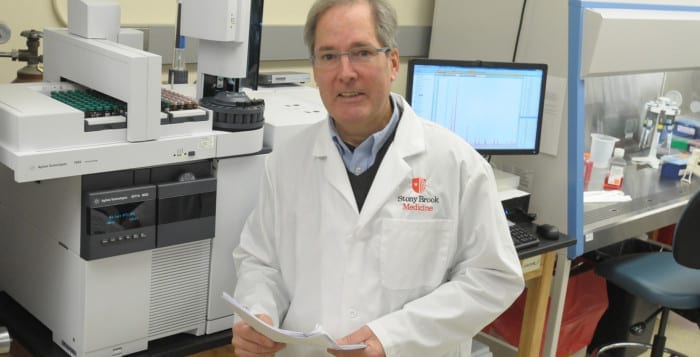Stony Brook’s Haley studies cancer metastasis
By Daniel Dunaief
Once they reach their destination, they wreak havoc, destroying areas critical to life. All too often, when cancer spreads, or metastasizes, through the body, it becomes fatal.
John Haley, a Research Associate Professor in the Pathology Department at Stony Brook, is trying to figure out how cancer become metastatic and, even further, what they do to avoid recognition by the immune system.
Haley is “working on the mechanisms by which metastasis occurs,” he said. He is also studying the “immune recognition of tumor cells and, in the near future, wants to link the two.”
Understanding the way metastasis works can greatly reduce mortality in cancer, Haley said. Researchers are currently attempting to develop therapies that target metastatic cells, but these are often more difficult to kill than their primary counterparts, Haley explained.
The stakes are high, as 90 percent of cancer deaths are due to complications from the spread of cancer rather than the primary tumor itself, he said.
About 80 percent of human cancers are carcinomas, which are derived from epithelial cells. Those are the cells that make up the skin, and line the stomach and intestines.
“As cancers become metastatic, those cells have the ability to shape shift,” he said.
They become much more like fibroblasts, which are underneath the skin and glue the skin to bone and make up connective tissue layers. Haley said he has made some progress in understanding the molecular mechanism that allows cells to shift from epithelial to fibroblastic cells. They have “defined factors which promote” this transition, with differences in survival and growth pathways.
Haley works with a machine called a mass spectrometer, in which he identifies proteins in complex biological samples and measures how changes in composition alters function. He spends about half his time working on his own research and the other half assisting other researchers who are seeking to get a clearer view of key changes in proteins in their work.
In his own research, he wants to understand how cancers modify a cell’s proteins. He has helped define how cancers can change their protein signaling pathways to become drug resistant, which suggests targets for drug therapies.
Haley is tapping into an area of science that many other researchers are exploring, called bioinformatics. Using statistics and mathematical models, these scientists are cutting down on the number of genes and proteins they study, honing in on the ones that have the greatest chance to cause, or prevent, changes in a cell.
“We’re taking the data sets we’ve generated and trying to predict what we should look for in human patient samples,” Haley said. “We can find a tumor cell that have mutations or this expression profile and find drugs they are sensitive to.” Once scientists find those drugs, researchers can test them in cell cultures, then in mouse models and eventually in people, he said.
“We try to isolate someone’s cancer to understand what the molecular drivers are that occur in that cancer,” Haley said. The approach, as it is much of modern medicine, is to understand the patient’s genetics and biochemistry to select for a drug that would be effective against the particular mutations present in their tumor.
A resident of Sea Cliff, Haley is married to Lesley, whom he met while he was pursuing his PhD at Melbourne University. A native Australian, Lesley was completing her Masters in Opera when the couple met at a tennis match. They still play today. Lesley has sung at New York premieres for several living composers at concert venues including Avery Fischer Hall. She teaches music at her studio in Sea Cliff. Their children share their interests. John is a freshman studying biochemistry at Stony Brook University and Emma, who is a senior at North Shore High School, plans to study science and singing.
As for his work, Haley would like to see his efforts culminate in cancer therapies and diagnostics. Any novel therapy might also become a product for a start up company which could create jobs on Long Island. “There are some fabulous scientists” at the university, he said. “A major goal of the Center for Biotechnology and Diane Fabel, its director, is to create small businesses here in New York. I’m trying to help them in that goal.”







